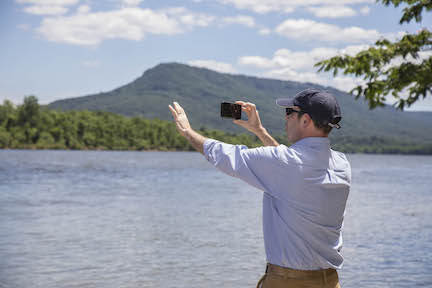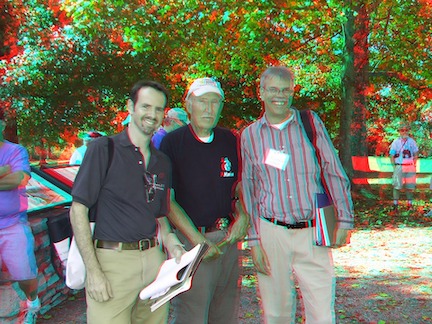A Conversation with Garry Adelman (part two)

part two of a six-part series
I’m talking this week with Garry Adelman, chief historian at the American Battlefield Trust. Known for his super-high energy, Garry has helped reshape Civil War public history with his engaging use of social media and his mission to connect preservation-minded CivilWar buffs with the history they help save. In the first part of our conversation, Garry explained how he “became obsessed with the Civil War in high school by picking up William Frassanito’s books,” and that, eventually, led him to relocate to Gettysburg.
Chris Mackowski: So once you got to Gettysburg, what got you into the history field there?
Garry Adelman: At first I worked 120 hours a week, then it was 100, then it was 80. Eventually, we got supervisors to help us and business was good, and I was down to 60 and then even 50 hours a week over the years, and the more that happened, the more time I had to do other things. In 1994, I took and passed the Licensed Battlefield Guide Exam, became a guide in 1995. By then, I’d written my first article for Gettysburg Magazine, and then by 1997, I wrote Devil’s Den: A History and Guide. I co-wrote that with Tim Smith.
So when I was running the restaurant, I was kind of getting into my Civil War career.
In 1992, I joined the Gettysburg Battlefield Preservation Association as a board member, started advocating for battlefields—which, by the way, is pretty funny because my goal in moving to Gettysburg was to pursue my passion, become a battlefield advocate, and write, which is pretty funny considering what I do now. (laughter)
Chris: You seem to have planned it out pretty well!
Garry: Yeah, this 25-year-old kid kind of laid out, “Okay this is what I’m going to do,” and I had no reason to think I could do it. I had never written anything before.
In the meantime, my girlfriend at the time—Gettysburg wasn’t for her, but I had everything I wanted there. I wasn’t ready to leave. So we wanted to sell the restaurant, and we found a buyer in Gettysburg College, who wanted to set up a new operation called Starbucks. Well, I was the only trained barista in some distance, so they asked me if I would consult, and I said “No, hire me to run it.” So, they bought my restaurant, and I ended up working for Gettysburg College and running their Starbucks operation, their snack bar called The Bullet Hole, and all their concessions, all their food services outside of their cafeteria.
Chris: Did working for the college free you up in the summer time?
Garry: Exactly. It was perfect. I had this great situation going there. I was at Gettysburg. I worked on the battlefield. It’s on the college campus—which is battlefield. And by that time—that’s from ’95 to ’99—I really solidified being a battlefield guide. I had already had a book out, I was speaking to round tables and, I was working on another book.
My next one came out in 2000, Little Round Top: A Detailed Tour Guide. I wrote more articles for Gettysburg Magazine and I appeared in Civil War News. It kind of started happening. And it was just a very gratifying and shocking experience that once this sort of trifecta of giving tours and speaking to groups and having something written came together, that’s when everything changed. Even before the days of social media, people started knowing who I was, and I didn’t know who they were. It was a very interesting phenomenon. Social media wasn’t around, but they would see you at a round table, they would see you on a tour, they’d see you on Pennsylvania Cable Network or something like that, so it was a really interesting time.
Chris: And then suddenly you wake up one day, and you’re like “Holy shit, it happened!” Almost like it crept up on you, and then suddenly there it was.
Garry: Yeah, yeah, and this is while I was still running restaurants. Another change happened, though: I realized I wanted to go back and study history officially. Remember, I didn’t have a history undergrad.
So in 1999, I did two things. I started working for Thomas Publications, then known as “The leader in Civil War books… and more.” I was their marketing guy. And they had a lot of great titles, and I had a great job there as well, so that was my exit from restaurants. I officially got out of restaurants in 1999.
And I also started pursuing my master’s in Applied History at Shippensburg University of Pennsylvania—where I had a great experience, by the way. And during that time, I was exposed to even more stuff.
By the way, for anyone reading, you should keep a journal. We historians, we just wish people would have written more stuff down about what we’re interested in—and you never know what it’s going to be. I strongly claim you are not a real historian unless you keep a journal or some sort of diary. I have one that is specific to the Civil War. I had the idea in 1990 that I was going to take this big, thick book of onion skin paper, and I was just going to write in it about Civil War stuff. And, incredibly, that thing lays out my whole journey—so all these stated goals I had, they’re all in there. It’s pretty cool.
I’ll never finish the journal, I’m sure. It’s about 900 pages of thin paper, and after writing in it for now twenty-nine years or so, it’s about half way full or a third of the way full or something like that. I’m writing in it more, hoping that I’ll make to the Gettysburg 200. I plan to be around for that. That’s the year 2063, and maybe the book will be filled by then. My kids know that they’re going to wheel me there if I’m still alive. (laughs)
In any case, while I was at Thomas Publications, I had written in my journal, “Mark my words: before long I shall crack the ceiling of getting on a Civil War documentary.”
Chris: So that was your next goal?
Garry: Ooh, yeah, and finally it happened. I got on one that was about William Frassanito. It was about Civil War photography, and there was one episode that was just about Frassanito, and he was somebody I knew. He had long since, along with my buddy Tim Smith, became my mentor and everything like that, so I was well-versed on him.
Of course, it was like two and a half years until it aired. Oh my God, that was a painful wait. But in the meantime, somebody couldn’t do an appearance on Civil War Combat, so I was on Little Round Top on a Civil War Combat thing, and that’s right around 2000. And that really freaks people out to see that, yes, I used to have a lot of hair and at one time I was in my 20’s and early 30’s. So that’s pretty fun.

At that same time, Tim Smith and I started giving battle walks for the Gettysburg National Military Park. Those are usually reserved for rangers, but we felt we had something to offer that other people don’t do—sort of a lot of post-battle and battlefield focus, a lot of photography focus. A lot of people didn’t really focus on that, especially back then. So for the better part of twenty years, we gave tours at the anniversary at these battle walks, and they were always filmed by Pennsylvania Cable Network. And again, you do one of those, and suddenly people know who you are. They invite you to their round table. They want you to write for their publication. Things really spiraled.
Chris: Did that open some doors for you?
Garry: Yeah, I stayed at Thomas Publications until 2002. Armed with my master’s, I went out looking for another job and found one at History Associates, Inc., in Rockville, Maryland. I found my dream job. This is a place that just hires historians and archivists to do things for them for hire; it’s a consulting firm—a consulting firm that made a lot of its money doing research to support litigation on either side. It was great because we were just fact finders, usually for environmental research, and either way the place would get cleaned up, it’s just a matter of who’s paying for it. It was really gratifying research and really detailed detective work. We also wrote books for corporations. That was fun and gratifying. We also did work for a lot of museums and whatnot.
While I was there, I started kind of carving out a Civil War niche. I was, like, “Hey, wouldn’t it be great to just be able to do Civil War stuff here?” So I would look for requests for proposals to respond to. On the second one, by an outfit known as the Civil War Preservation Trust, I did an RFP for their Third Winchester battlefield, and we submitted for that and applied for it and got it.
Chris: So your first interaction with the Trust!
Garry: And my first battlefield layout. I had helped writing a few signs before—and by the way, anyone who’s done that feels the weight of responsibility, especially when you first start doing it: “Oh my God, this is it—it’s in the ground.” Semi-permanent or permanent, it has a real impact.
So along with my buddy Tim Smith, whom I brought on as a contractor, and Amber Molten Wiseman, who’s a professor, we laid out that battlefield and wrote 22 signs—later learning that 22 is way too many for a battlefield trail and way too expensive. We learned about a lot and started really experiencing the push and pull between access and preservation. Is it better to get people out to a battlefield? What if they want to go on a bike? What if they have mobility issues? Does it have to be a flat surface? What about just grass? What about when you’re going down a hill and you want to have the liability of people slipping down a hill or something like that?
This was, in parts, a controversial project because, for some parts of it, we wanted bikes to be able to pass each other and secured a grant from a foundation that wanted the paths to be bike accessible. Money makes the world go round, and we couldn’t have possibly done this interpretation without it. But there was also some public backlash and outcry. We learned some things as a result.
But now, I mean, it’s a great thing for the community; it’s very gratifying.
————
Although his career up to this point has given him increasing visibility, his job with the American Battlefield Trust really thrust Garry into the national spotlight. In tomorrow’s segment, we’ll talk about making the transition to the Trust and how that impacted him.
Enjoying this interview very much! Looking forward to parts 3-7.
Thanks, Chris. I reorganized, so there’ll only be six parts instead of seven. The content will all be there, though, so no worries!
Best interview ever. Glad Garry took the time to share his Civil War life with us. We’re not alone.
Glad you’re enjoying it!
What I want to know is did you have to chase him, or did he actually sit sort of still for the interview?
Ha! We actually had the chance to sit and shoot the breeze for well over an hour, uninterrupted!
I thought “ lightly edited” would mean “ calming and focusing Gary.” I’m glad I was wrong. This is classic Gary Adelman. The energy and enthusiasm jumps off the page. I love it! Looking forward to the remainder.
“Calming” would remove all his charm…. 😉
Glad you’re enjoying the interview!